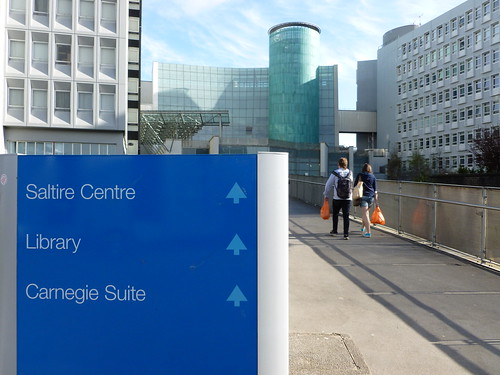This was my second time attending LILAC. When I went to Limerick in 2010, it was less than six months after I had reentered academic librarianship, after a 2 year stint as Librarian of CILT, the National Centre for Languages. I therefore felt a bit out of the loop and didn't really know anyone there. It's such a friendly conference though that I soon got chatting to people. I was so inspired that after attending I successfully applied for the role of marketing officer for the CILIP CSG Information Literacy Group (who organise LILAC). Unfortunately, last year's LILAC clashed with a trip to Barcelona. I was therefore really keen to attend this year and was over the moon when my manager gave me and my colleague Ida the go ahead.
 |
| The setting for LILAC 2012: the Saltire Centre, Glasgow Caledonian University |
LILAC has become such a prestigious event both at home and abroad that it is able to attract impressive keynote speakers. To begin the conference was Megan Oakleaf, the "Meryl Streep of the library world" (due to the number of awards she has won). You can visit Megan's website at www.meganoakleaf.info
The title of Megan's presentation was Playing the ACE: assessing, communicating and expanding the institutional impact of IL. Megan said she came up with this concept whilst in Las Vegas. Megan talked about the ACRL 2010 report on the value of academic libraries www.acrl.org/value As she put it, it's about moving from thinking about the stuff to considering what people do with the stuff. In other words, its impact and the return on investment. We should be asking ourselves "How do we impact our institutional mission?" and we need to be collecting data and evidence to prove this. Some ideas:
- Assessing IL - define and assess Learning Outcomes in an institutional or employability context.
- Develop systems to collect data on individual library user behaviour
- Who is using presentation/study rooms? Connect to other data.
- Record and increase library impact on student enrollment.
Libraries have been show to be the 2nd most impactful facilities for student admission decisions. Why is this? We need to know!
Useful related research can be found in this post by Megan http://www.acrl.ala.org/value/?p=144 Other research at Wisconsin showed that after the 1st year, library instruction impacts Grade Point Average at graduation. However, another recent study at Minnesota highlights that data doesn't always say what you want it to, as student performance decreased after library instruction.
In order to demonstrate and develop library impact on student learning, Megan has devised an instruction impact map, first introduced in Library Quarterly, 2011, 81 (1), which you can view at http://meganoakleaf.info/libraryimpactmap.pdf
Some questions / points to consider:
- Do students transfer skills to other contexts?
- Student experience. For them it's all the same - library, finance, etc. Making connections and focusing on building relationships is therefore important so they know what we do.
- Retention - do we help students stay?
- One way to help employability is to promote obtaining company profiles for interviews from our databases.
- Tell your library's value story by highlighting things that relate to student learning, retention, etc.
- Make sure what you're doing matters. Determine what is less important.
- Assessment - need to see sample of student work. Should be central to pedagogy. See Megan's article “Writing Information Literacy Assessment Plans: A Guide to Best Practice.” Communications in Information Literacy 3, no. 2 (2010): 80-90. Also see www.railsontrack.info
- A book recommended by Megan was Understanding by design by Grant Wiggins and Jay McTighe.
- No use just demonstrating how to ride a bike, students need to have a go themselves to learn effectively.
